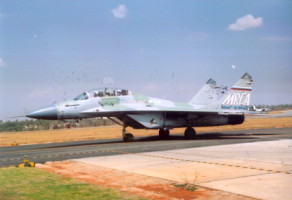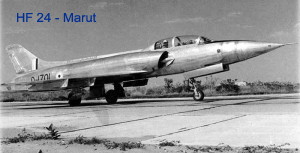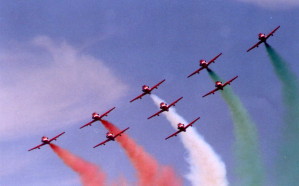INDIA DEFENCE CONSULTANTS
|
WHAT'S HOT? –– ANALYSIS OF RECENT
HAPPENINGS |
|
AERO INDIA 2003 –– Aviations' Centenary Year An IDC Report
|
|
New Delhi, 26 February 2003 Aero
India 2003 Part
1 –– Celebrating Aviations’ Centenary Year By Jai Misra
MiG 29 at Yellahanka The
centenary year of man’s first manned, powered and controlled
flight (well, just about controlled, anyway!) by the Wright Brothers
in the USA, got off to an impressive start in far away India. This
was somehow appropriate because 600 years ago, it was India that
Christopher Columbus was trying to reach after all when he
discovered America! The aviation centenary’s subsequent events in
Australia, Germany, Abu Dhabi, and USA, culminating in the biennial
Paris Air Show in June were still in the offing when Indian Air
Force Station Yelahanka in South India found itself already in the
aviation news, staging Aero India 2003 between 5–9 Feb
2003. This was not a first for Yelahanka either and thereby hangs a
tale: Yelahanka
Revisited It was in British India of the mid-1940s that a military airstrip came to be built for use of the Royal Air Force near the sleepy little village of Yelahanka, some 15 kilometres north of the largely military township of Bangalore cantonment. As in the case of some of the other wartime airstrips built in India, use was probably made of the captive labour force available in the form of thousands of Italian combatants shipped out from Africa to the many POW camps in India, following Italy’s surrender in Ethiopia. There were apparently three such in Bangalore, at Jalahalli, Hebbal and Jakkur, housing no less than 23,000 POWs. At
the end of World War II the airstrip fell into disuse, doing
occasional duty thereafter as an automotive racing track, the fate
of many such wartime airfields the world over. It was in 1963 that
the Indian Air Force decided to shift its Transport Training Wing
from Begumpet airfield in Hyderabad to Yelahanka. That same year,
the then Indian Air Force Chief, Air Chief Marshal Arjan Singh DFC
(later to become the first Marshal of the Indian Air Force) arrived
on an inspection of the technical training establishments in nearby
Air Force Station Jalahalli. When the Air Chief expressed a desire
to visit Yelahanka which was being reactivated as an airfield, the
local Air Force brass hastily drew up a convoy of cars, complete
with pilot jeep and invited the Air Chief to board his official
staff car. As soon as the convoy moved off along the paved road, the
Air Chief called a halt, saying that he knew from his wartime
service of a much shorter cross-country route from Jalahalli to
Yelahanka. Since no one else present seemed to know of it, the
redoubtable Arjan Singh took the wheel of the pilot jeep and
personally jolted his own convoy “over field and stream” on to
Yelahanka, to the consternation of all, particularly his young ADC! Another
veteran, the late Group Captain John Mckenzie, also of the Indian
Air Force, recalled his squadron’s temporary withdrawal from
operations in Burma to wartime Yelahanka to re-equip with Spitfires.
John’s rusty but trusty Hurricane had served him Among the other senior septuagenarians and junior octogenarians from various countries who remembered those days was former President Weizmann of Israel, then a young pilot with an RAF squadron at Yelahanka. On an official visit to Bangalore in the 1990s, the President recalled his wartime weekly Sabbath visits to some prominent Jewish families in Bangalore with nostalgia. Press reports of the Presidential visit suggested that these visits tended to be noticeably more to one family than the others, but the President’s tight security detail saw to it that the eager newshounds were left guessing which family it was and, more importantly, why. All that could be gathered was that the President was indeed unmarried at the time! Cut
to the present: some 60 years later, an Israeli UAV Heron gets
airborne from Yelahanka on 5th February 2003 at 9:15 hrs,
just before the Opening Day of Aero India 2003 and stays airborne
till the ceremonies end, beaming aerial coverage of the five-hour
ceremony and the flying displays to the massive stall of the Israeli
Aircraft Industries. Was it looking for “something or someone
special?” Moving
on, the first Aero India was staged in 1993 as a small privately
organized event but the subsequent and progressively bigger ones in
1996, 1998 and 2001 were sponsored by the Government of India and
staged by the Ministry of Defence and its Departments of Defence
Production and Supplies, Defence Research and Development along with
participation from the Civil Aviation Ministry and the Department of
Aerospace. Indian Air Force Station Yelahanka remained the host,
although of course no one would recognize it as a wartime airfield
anymore. The
Indian Air Arsenal India’s
Defence Minister, Mr George Fernandes, muttering in his unique way
and not
The
flying display then got off to a dramatic start with the flypast of
the Air Force’s
In
the rotary wing section, apart from the Mi-8, the Dhruv (as the
Advanced Light While
on variants, it was Picture credits: Ranjit Rai, Bharat-Rakshak, Highgallery |

 fastest and slowest. It was a most impressive
sight to see the Dhruv helicopter leading the formation as the
slowest with its nose determinedly down going flat out while the two
Su-30MKI supersonic fighters flying wingmen had their noses up at an
impossible angle, seeming to struggle to stay airborne at that
speed, belying their superb controllability. Such a flypast must be
unique in any air force.
fastest and slowest. It was a most impressive
sight to see the Dhruv helicopter leading the formation as the
slowest with its nose determinedly down going flat out while the two
Su-30MKI supersonic fighters flying wingmen had their noses up at an
impossible angle, seeming to struggle to stay airborne at that
speed, belying their superb controllability. Such a flypast must be
unique in any air force.  The
second technology demonstrator of the Indian designed and built
fourth-generation Light Combat Aircraft was also shown in the air,
raising many inquiring and admiring glances from aviation experts of
several countries. Over 50 flights of this smallest and lightest of
the world’s fourth-generation fighters have already taken
The
second technology demonstrator of the Indian designed and built
fourth-generation Light Combat Aircraft was also shown in the air,
raising many inquiring and admiring glances from aviation experts of
several countries. Over 50 flights of this smallest and lightest of
the world’s fourth-generation fighters have already taken
 Helicopter has been christened in the Indian Air
Force), showed its paces and generated a respectable level of
interest, as did a mockup of its armed variant the Light Combat
Helicopter, projected as the world’s lightest and expected to fly
in 2006. The offshore operator Azal India Limited has already
ordered the civil version of the ALH.
Helicopter has been christened in the Indian Air
Force), showed its paces and generated a respectable level of
interest, as did a mockup of its armed variant the Light Combat
Helicopter, projected as the world’s lightest and expected to fly
in 2006. The offshore operator Azal India Limited has already
ordered the civil version of the ALH.